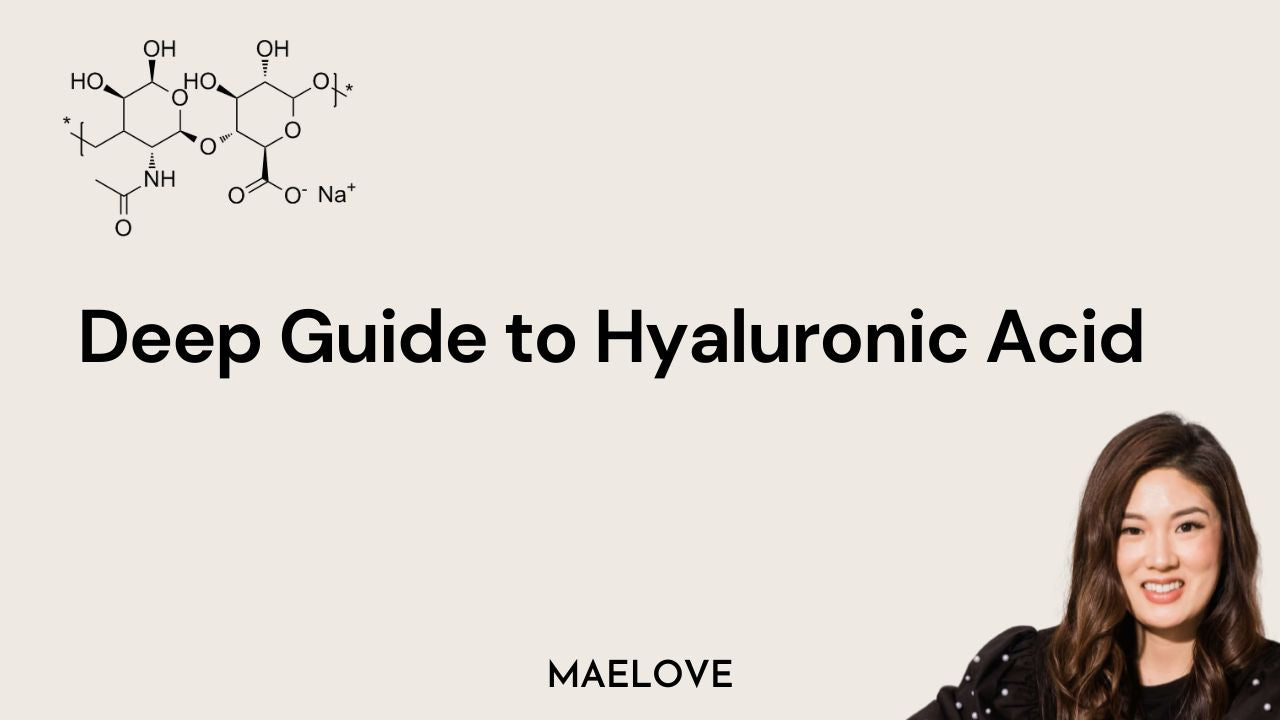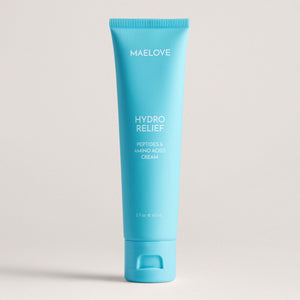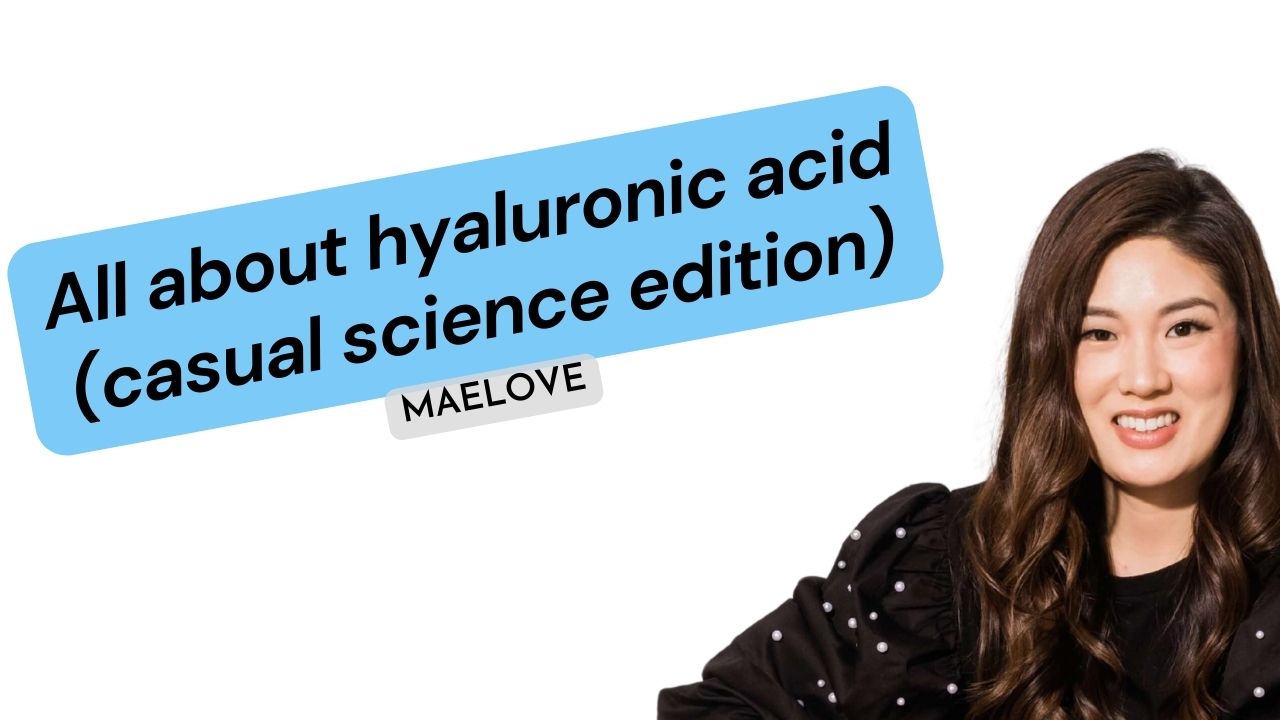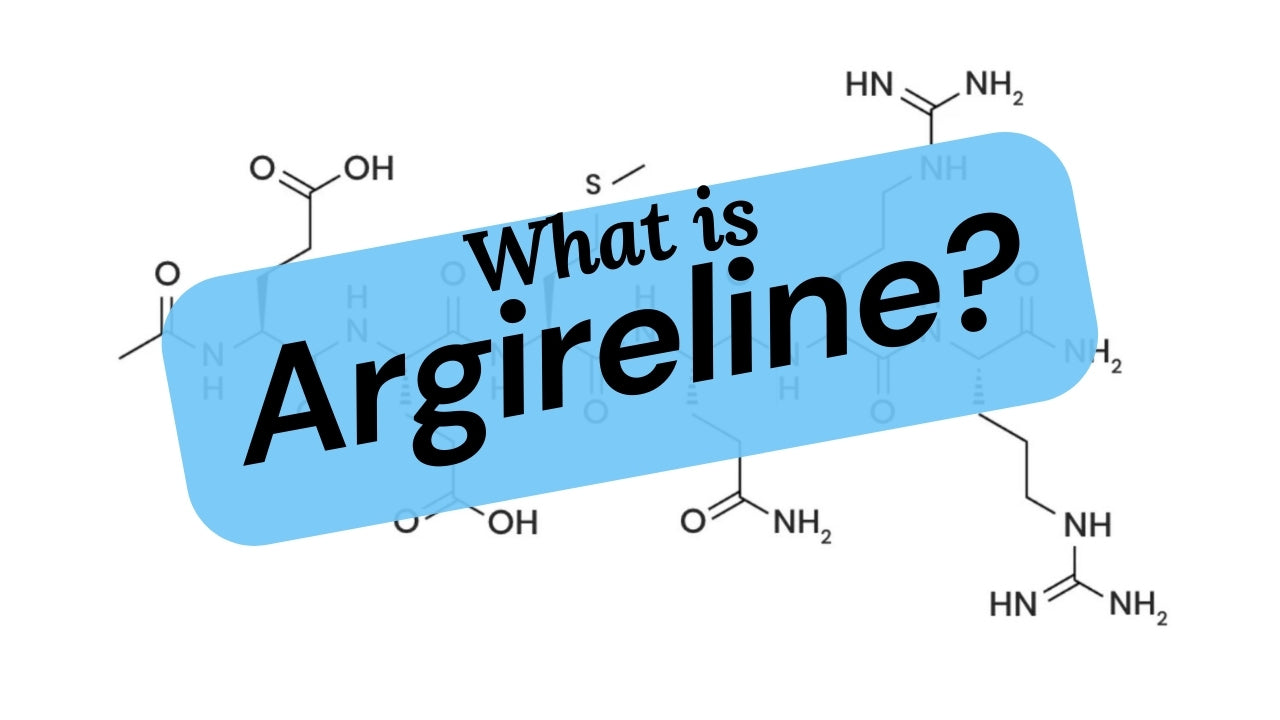Hyaluronic acid is a popular skincare ingredient—and for good reason. Known as 'nature’s moisturizer,' it attracts and holds water, retaining up to 1,000 times its own weight in moisture!
Here, we will deep dive through the ins and outs of what hyaluronic acid is, why it is a popular skincare ingredient, and what to look for in skin products that feature this ingredient.
This is our science-heavy version for the nerds (If you want to just learn the basics about this effective ingredient, please click here ). Let's go!
What is Hyaluronic Acid?
Hyaluronic acid (HA) is a polysaccharide. This means that it is made up of sugar molecules bonded together.
Specifically, hyaluronic acid is formed by repeating units of 2 sugars, one of which is d-Glucuronic acid and the other is d-N-acetylglucosamine.
These sugars form chains that can get very large, in fact several thousands of sugars long. What makes this particular polysaccharide special is that it can make long and loose chains when mixed with water.
These long chains can intertwine together forming a jelly that allows hyaluronic acid to hold 1,000 times its weight in water. This water attracting and holding property makes it an effective humectant that has many uses including the hydration of skin.
Humectants are usually incorporated into moisturizing serums and creams because they can hold onto water to help hydrate the skin.
Though it consists of simple chains of repeating units of 2 sugars, hyaluronic acid can have a vast number of configurations and forms dependent on its size, salt concentration, pH and associated cations, making it a versatile humectant (Necas et al 2008, Snetkov et al. 2020).
Due to its water holding capacity and versatility, hyaluronic acid holds a unique place in nature, found naturally in many organisms including humans. For this reason, hyaluronic acid has been described as "Nature’s Moisturizer" (Necas et al 2008).
It is found throughout the human body including the umbilical cord, synovial fluid, the vitreous of the eye and in your skin. It is also present in all tissues of the body including skeletal tissues, heart valves, the lung etc. Your skin accounts for 50% of your body’s total hyaluronic acid content (Papakonstantinou et al. 2012).
On average, the dermis (the layer underneath the epidermis) contains 0.2-0.5mg/g of hyaluronic acid, and the deeper layers of the epidermis contains 0.1 mg/g of hyaluronic acid (Snetkov et al. 2020).
Hence, it is found underneath the top visible layer of your skin. The top visible layers do not contain hyaluronic acid. Instead, the skin barrier is formed by these top layers of the epidermis which are rich with waterproofing lipids such as ceramides, cholesterol, and fatty acids.
Specifically, the outermost is the visible stratum corneum layer which are rich in these lipids and right below that, the stratum granulosum layer which has something called tight junctions which also helps form the skin barrier. These top waterproofing and barrier forming layers prevents the evaporation of water while the lower layers of the epidermis and dermis are full of hyaluronic acid to hold that water.
Only the dermal layer has blood vessels, whereas the epidermal layers get hydration from diffusion of water from the dermal layer. Hyaluronic acid absorbs water from the blood stream to maintain hydration. Loss of either hyaluronic acid or the lipid waterproofing (both of which decline with aging), leads to dry skin.
The dermal layer also contains collagen, elastin, and other structural proteins that form the main scaffolding of your skin. Hyaluronic acid is actually just one of the glycosaminoglycans (GAGs) found in the dermal layer of your skin.
GAGs is just a descriptor for these kinds of polysaccharides that form these long linear chains that can hold water. Other GAGs include dermatan sulfate, with chondroiton 4-sulfate and chondroitin-6 sulfate found in smaller amounts.
Together, these structural proteins and water-holding GAGs form the extracellular matrix (ECM) that gives your skin it’s structure including its firmness, smoothness, elasticity, and plumpness. GAGs are necessary to maintain skin hydration and turgor. It also plays a role in the transport of water-soluble nutritional material to your skin cells.
Hyaluronic acid is the most predominant component of the ECM (Papakonstantinou et al. 2012).
Why is Hyaluronic Acid popular for aging skin and skin conditions?
Hyaluronic acid is popular as a powerful humectant that is well-tolerated even by the most sensitive skin types - because it is naturally found in the body.
What does this mean? Well, even if you have very sensitive skin or skin prone to allergic reactions like in conditions such as rosacea, eczema, or psoriasis, hyaluronic acid will not cause a skin reaction because it is natural to the skin and will not create an inflammatory, allergic response.
In other words, it is universally well tolerated. Hence, it is popular in both serums and creams that aim to hydrate dry and damaged and aged skin.
As you age, dry skin becomes more and more of an issue. This is in part because natural levels of GAGs like hyaluronic acid decline, contributing to dry skin. With aging, it disappears from the lower levels of the epidermis, and the size and levels of hyaluronic acid in the dermis decrease as well.
With photoaging, this decline accelerates. Photoaging results in abnormal GAG content with diminished hyaluronic acid and increased chondroitin sulfate proteoglycans. Existing hyaluronic acid is also degraded in photoaged skin (Papakonstantinou et al. 2012). In other words, your skin’s water holding ability decreases the more it's exposed to the sun.
Compounding this is the loss of waterproofing lipids such as ceramides in the top layers of the skin, which allows more water to evaporate leading to skin dryness.
One solution to this problem is hydrating serums, lotions, and creams applied topically. Humectants like hyaluronic acid love water and hold it while lipids such as ceramides, oils, waxes and fats help prevent evaporation of water.
Using a topical product which contains hyaluronic acid basically creates hydration atop of your skin and creates a humid microenvironment which increases moisture content within the skin and limits evaporation of water from the skin.
It is a humectant, and there are other humectants such as natural moisturizing factors (NMFs) that also serve a similar function. However, few compounds match the water holding ability of hyaluronic acid.
What’s great about hyaluronic acid is that it is so water loving and so effective a humectant, a little goes a long way. Plus it has no real toxic effects since it is a natural part of your body.
Products made from hyaluronic acid have many other uses outside of skin moisturizers including artificial tears, wound healing hydrogels and orthroarthritis treatment (Gupta et al 2019, Snetkov et al. 2020, Li et al. 2020). Hyaluronic acid is naturally involved in wound healing in the human body as well (Chen and Abatangelo 1999).
How to use Hyaluronic acid skincare products?
Hyaluronic acid plays well with other ingredients whether it is found in a serum or a cream. If found in a serum, you can layer it on with other serums applying serums from thinnest to thickest. If found in a cream, apply that after your serums.
If you are in a very dry environment such as in an arid climate, in winter, or on an airplane, you can also spritz your skin with water first before applying the hyaluronic acid product.
This is because hyaluronic acid is so effective at pulling and holding water, you will want it to pull water from its environment instead of from your skin. This will allow the product to create a hydrating microenvironment for your skin.
At Maelove, we have a specialty hyaluronic acid serum that also contains panthenol called The Hydrator [check out Hydrator B5 Gel].
However, you will also find it in featured in a number of our other products including
Glow Maker Vitamin C serum [Link]
Peptide Squad Serum [Link]
Eye Enhancer de-puffing cream [Link]
Night Renewer glycolic acid cream [Link]
Plush lightweight moisturizing cream [Link]
Sheer Silk ceramide cleanser [Link]
If you start using your serums/ creams soon after you buy it, you can keep it at room temperature. However, if you will not use it for a while, keep serums and creams with hyaluronic acid in the refrigerator.
This is because at room temperature, hyaluronic acid can slowly degrade (up to a point) over time and this decreases its humectant ability. However, refrigeration inhibits the degradation process (Snetkov et al. 2020).
Why are there so many types of Hyaluronic Acid available?
The different types of hyaluronic acid represents different lengths (sizes) of hyaluronic acid. In it’s natural state, hyaluronic acid is a very long molecule that can get very large, in fact several thousands of sugars long.
Typically, the hyaluronic acid in your products is shorter. However, for the most part, hyaluronic acid is still too large to enter into your skin as a big molecule. It sits on top of the skin and does not get absorbed.
Over the years however, some researchers have made very small sized hyaluronic acid that can penetrate into the skin and lead to improvements in skin hydration and firmness (Essendoubi et al. 2016, Shigefuji and Tokudome 2020, Lubart et al. 2019, Jegasothy et al. 2023, Liu and Nassim 2020).
However, this strategy is controversial as the small sized hyaluronic acid that can penetrate the skin may be inflammatory and promote an inflammatory response which can slow down healing (Snetkov et al. 2020, Papakonstantinou et al. 2012, McKee et al. 1996, Lee et al. 2021, Collins et al. 2011, Necas et al 2008).
What does that mean for you? If you want to avoid small sized hyaluronic acid that may be inflammatory, you will want to avoid anything that says “hydrolyzed hyaluronic acid” or otherwise implies hyaluronic acid has been cut up into extra small pieces to help penetration.
What to look for instead? Well, what may be confusing about hyaluronic acid is that it is also known as hyaluranon. These are names for the same thing. Further, sodium hyaluronate is just the sodium salt version of hyaluronic acid.
That sounds confusing but just think, table salt is just sodium ions with chloride ions. They are attracted to each other because sodium ions have a positive charge and chloride ions have a negative charge. Hyaluronic acid also has a negative charge so it will attract positive sodium ions. When dissolved in water, the ions separate and you are left with sodium ions and hyaluronic acid.
The story is slightly more complicated with the pH of the solution also coming into play, but basically, hyaluronic acid, hyaluranon, and sodium hyaluronate are essentially the same ingredient. The version you are most likely to see on your ingredient label is sodium hyaluronate (Necas et al. 2008).
So overall, applying hyaluronic acid to the surface of your skin should not increase its levels under your skin since it should not pass the stratum corneum. If you want to increase the levels of hyaluronic acid within your skin, the topical products to use are actually retinoids.
Retinoids can increase hyaluronic acid in the dermis and basal epidermis, and this is part of how retinoids helps improve wrinkles (Margelin et al. 1996). So if you want to increase hyaluronic acid levels inside the skin, try a retinoid like retinaldehyde, retinol, or tretinoin.
What about oral Hyaluronic Acid or Hyaluronic Acid fillers?
Another route by which hyaluronic acid may be increased in the skin is by taking pills orally which contain hyaluronic acid. Research shows that this has benefits for the skin, reducing wrinkles and improving skin suppleness (Oe et al. 2017).
However, proceed with caution as there is some concern that oral hyaluronic acid formulations may promote the growth of certain cancers. In one study, it was found the pancreatic cancer cells could “feed” itself with hyaluronic acid in the surrounding tumor microenvironment (Kim et al. 2021). Hence, it is contraindicated for those with cancer (Simone and Alberto 2015). We suggest that you consult your doctor about taking oral hyaluronic acid.
Another option - one that can give you visible results quickly - is to get hyaluronic acid into the dermis with injectable dermal fillers such as Juvederm or Restylane. Injectible fillers can be invasive and damage nerves and blood vessels however, so go to a reputable medical professional if you take this route.
References
Chen WYJ, Abatangelo G (1999). “Functions of hyaluronan in wound repair.” Wound Rep Reg 7: 79-89.
Collins SL, Black KE, Chan-Li Y, Ahn YH, Cole PA, Powell JD, Horton MR (2011). “Hyaluronan Fragments Promote Inflammation by Down-Regulating the Anti-inflammatory A2A Receptor.” Am J Respir Cell Mol Biol 45: 675-683.
Essendoubi M, Gobinet C, Reynaud R, Angiboust JF, Manfait M, Piot O (2015). “Human skin penetration of hyaluronic acid of different molecular weights as probed by Raman spectroscopy.” Skin Res Tech 22(1): 55-62.
Gupta RC, Lall R, Srivastava A, Sinha A (2019). “Hyaluronic Acid: Molecular Mechanisms and Therapeutic Trajectory.” Front Vet Sci 6: 192. Doi: 10/3389/fvets.2019.00192.
Jegasothy M, Zabolotniaia, Bielfeldt S (2014). “Efficacy of a New Topical Nano-hyaluronic Acid in Humans.” J Clin Aesthetic Dermatol 7(3): 27-29.
Kim PK, Halbrook CJ, Kerk SA, Radyk M, Wisner S, Kremer DM, Sajjakulnukit P, Andrew A, Hou SW (2021). “Hyaluronic acid fuels pancreatic cancer cell growth.” eLife. https://doi.org/10.7554/eLife.62645.
Lee BM, Park SJ, Noh I, Kim CH (2021). “The effects of the molecular weights of hyaluronic acid on the immune response.” Biomaterials Research 25:27.
Li S, Dong Q, Peng X, Chen Y, Yang H, Xu W, Zhao Y, Xiao P, Zhou Y (2022). “Self-Healing Hyaluronic Acid Nanocomposite Hydrogels with Platelet-Rich Plasma Impregnated for Skin Regeneration.” ACS Nano 16(7): 11346-11359.
Liu K, Nassim J (2020). “The hype on hyaluronic acid.” https://www.health.harvard.edu/blog/the-hype-on-hyaluronic-acid-2020012318653. Accessed Jun 26 2024.
Lubart R, Yariv I, Fixler D, Lipovsky A. “Topical Hyaluronic Acid Facial Cream with New Micronized Molecule Technology Effectively Penetrates and Improves Facial Skin Quality: Results from In-vitro, Ex-vivo, and In-vivo (Open-label) Studies.” J Clin Aesthet Dermatol 12(10): 39-44.
Margelin D, Medaisko C, Lombard D, Picard J, Fourtanier A (1996). “Hyaluronic acid and dermatan sulfate are selectively stimulated by retinoic acid in irradiated and nonirradiated hairless mouse skin.” J Invest Dermatol 106(3): 505-509.
McKee CM, Penno MB, Cowman M, Burdick MD, Strieter RM, Bao C, Noble PW (1996). “Hyaluronan (HA) Fragments Induce Chemokine Gene Expression in Alveolar Macrophages.” J Clin Invest 98(10): 2403-2413.
Necas J, Bartosikova L, Brauner P, Kolar J (2008). “Hyaluronic acid (hyaluronan): a review.” Veterinarni Medicina 53(8): 397-411.
Oe M, Sakai S, Yoshida H, Okado N, Kaneda H, Masuda Y, Urushibata O (2017). “Oral hyaluronan relieves wrinkles: A double-blinded, placebo-controlled study over a 12-week period.” Clin Cosmet Investig Dermatol. 10: 267-273.
Papakonstantinou E, Roth M, Karakiulakis G (2012). “Hyaluronic acid: A key molecule in skin aging.” Dermato-Endocrinology 4(3): 253-259.
Shigefuji M, Tokudome Y (2020). “Nanoparticulation of hyaluronic acid: A new skin penetration enhancing polyion complex formulation: Mechanism and future potential.” Materialia 14: 100879. Doi/10.1016/j.mtla.2020.100879.
Simone P, Albert M (2015). “Caution should be used in long-term treatment with oral compounds of hyaluronic acid in patients with a history of cancer.” Clin Drug Investig 35(11): 689-692.
Snetkov P, Zakharova K, Morozkina S, Olekhnovich R, Uspenskaya M (2020). “Hyaluronic Acid: The Influence of Molecular Weight on Structural, Physical, Physico-Chemical, and Degradable Properties of Biopolymer.” Polymers. 12: 1800. Doi:10.3390/polym12091800.





